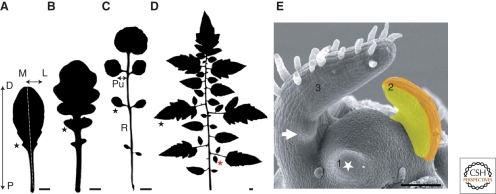Figure 1.
Axes of leaf asymmetry and diversity of leaf shape. (A) A simple, serrated leaf of the Columbia ecotype of Arabidopsis thaliana. The proximo–distal (P–D) and medio–lateral (M–L) axes are indicated in the image. The asterisk marks one marginal serration. (B) The lobed leaf of the Arabidopsis thaliana relative Arabidopsis lyrata. The asterisk depicts the position of one lobe. Lobes are deep serrations, so the definition of an outgrowth as a serration or lobe is somewhat arbitrary. (C) The dissected leaf of Cardamine hirsuta. The asterisk marks a lateral leaflet. Leaflets are clearly defined as distinct units of the same leaf, which connect with the rachis (R) via a structure called a petiolule (Pu). (D) The dissected leaf of the cultivated tomato. Tomato demonstrates additional orders of dissection with respect to Cardamine hirsuta leaf and produces both primary leaflets (black asterisk) and secondary leaflets (red asterisk). (E) Scanning electron micrograph of the shoot apex of tomato. The white asterisk marks a leaf primordium (1) initiating from the meristem. The adaxial (yellow) and abaxial (orange) domains are marked on the subsequent developing leaf (2). Tomato is a compound leaf plant where leaflets are formed from the leaf blade soon after leaf initiation (a developing leaflet is marked by an arrow in leaf 3). Images in panels A–D are leaf silhouettes. Scale bars: (A–D) 1 cm, (E) 100 µm.

